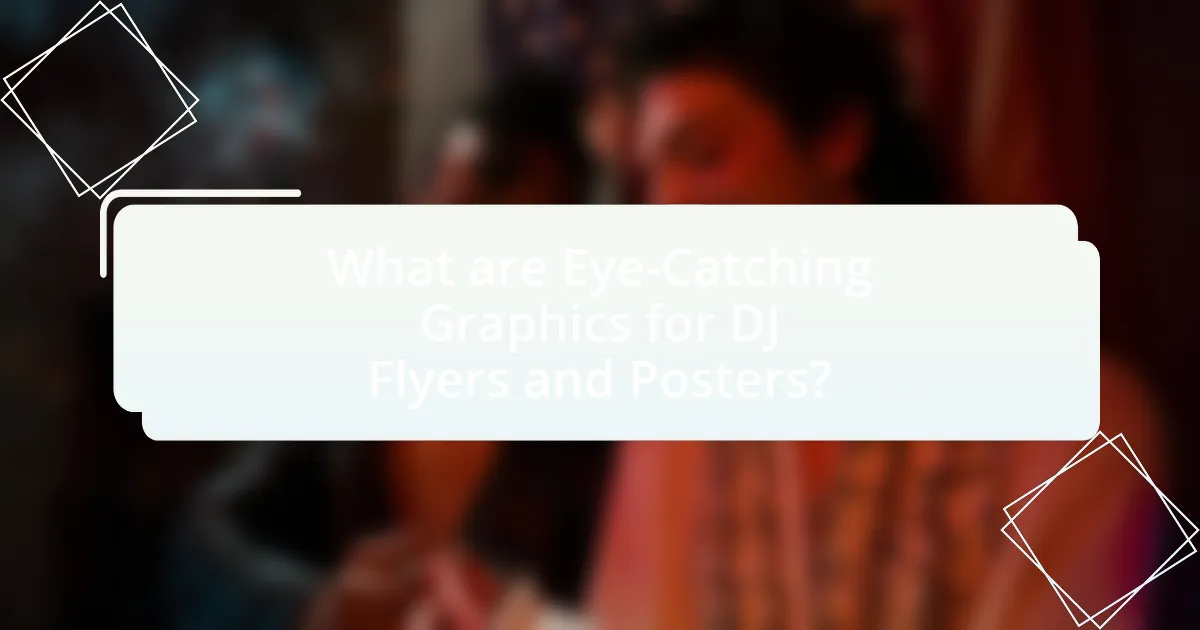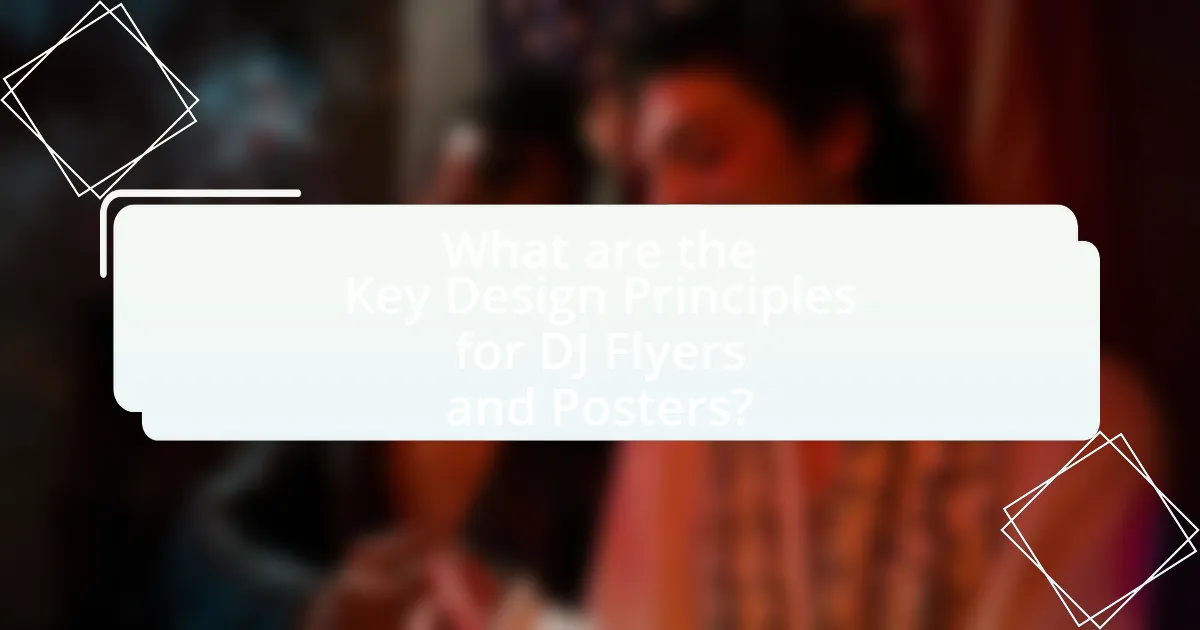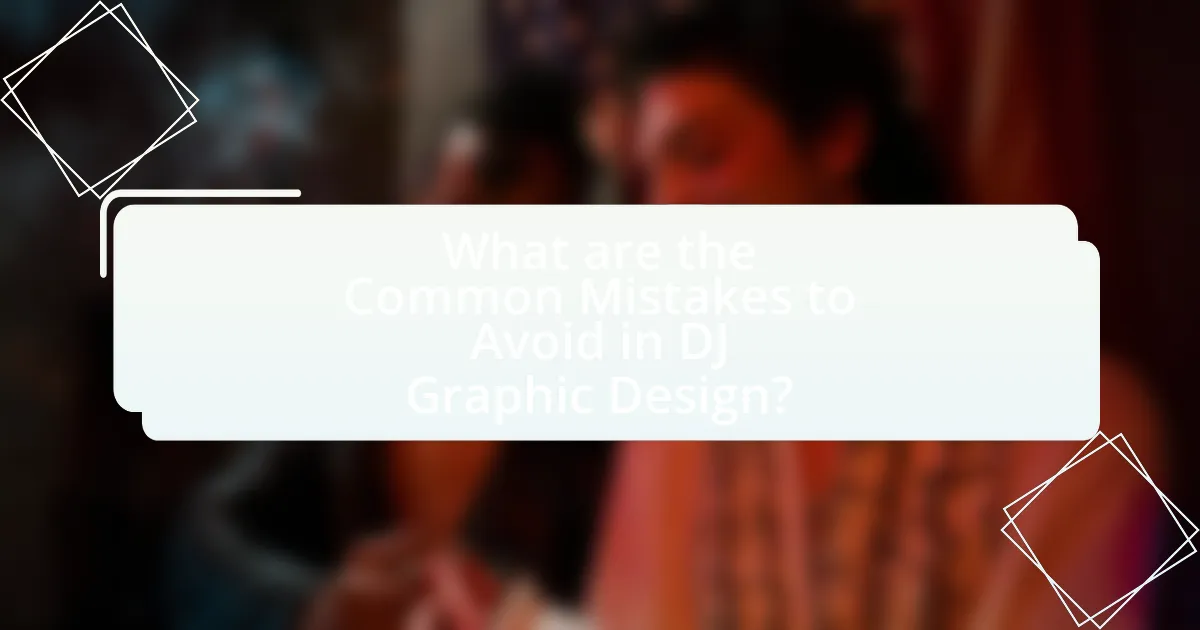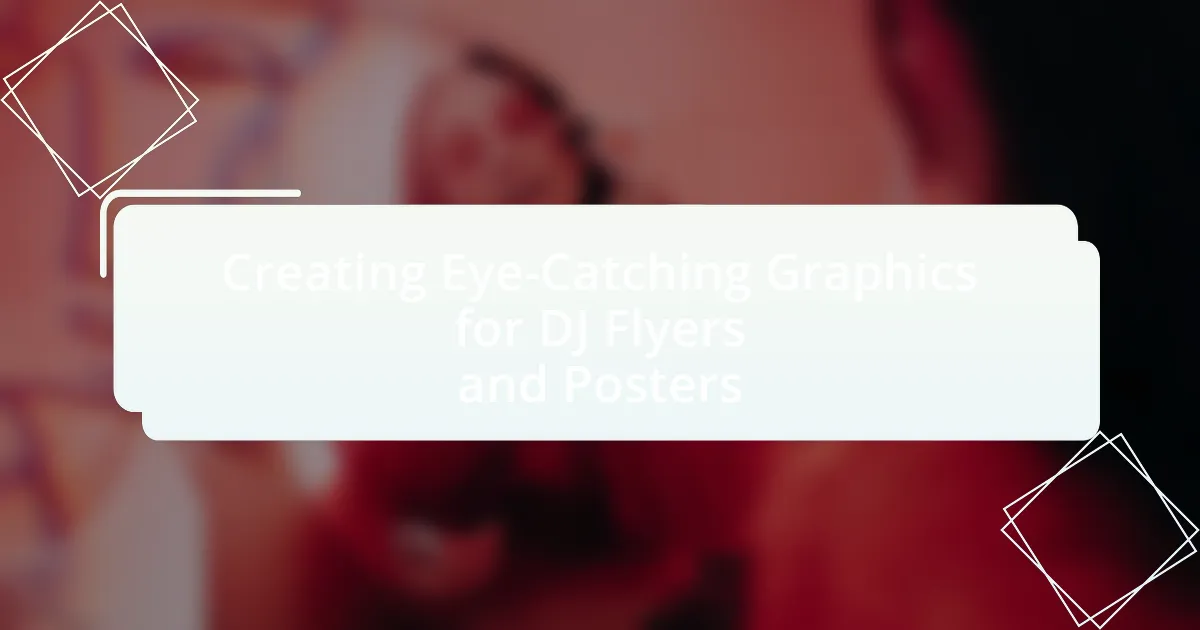Creating eye-catching graphics for DJ flyers and posters involves utilizing bold colors, dynamic typography, and engaging imagery to capture attention and convey the event’s energy. Effective graphics enhance viewer engagement, evoke emotions, and align with audience expectations, significantly influencing event participation. Key design principles include clarity, hierarchy, color contrast, and effective typography, all of which contribute to the overall impact of promotional materials. Additionally, understanding the target audience and avoiding common design mistakes are crucial for creating memorable and effective graphics that drive attendance and brand recognition.

What are Eye-Catching Graphics for DJ Flyers and Posters?
Eye-catching graphics for DJ flyers and posters are visually striking designs that effectively capture attention and convey the event’s energy. These graphics often utilize bold colors, dynamic typography, and engaging imagery, such as DJ portraits or abstract patterns, to create an immediate visual impact. Research indicates that designs featuring high contrast and vibrant hues can increase viewer engagement by up to 80%, making them more likely to remember the event. Additionally, incorporating elements like geometric shapes or motion effects can enhance the overall appeal, ensuring that the flyer or poster stands out in crowded environments.
How do graphics influence the effectiveness of DJ flyers and posters?
Graphics significantly enhance the effectiveness of DJ flyers and posters by capturing attention and conveying information quickly. Visually appealing designs, such as bold colors and dynamic imagery, can attract potential attendees, increasing the likelihood of event participation. Research indicates that people process visual information 60,000 times faster than text, emphasizing the importance of graphics in communication. Additionally, effective graphics can evoke emotions and set the tone for the event, aligning with the music genre and audience expectations. For instance, vibrant and energetic visuals may appeal to a younger crowd, while minimalist designs might attract a more sophisticated audience. Thus, the strategic use of graphics directly correlates with the promotional success of DJ events.
What elements make graphics visually appealing for promotional materials?
Visually appealing graphics for promotional materials incorporate elements such as color, typography, imagery, layout, and branding. Color plays a crucial role in evoking emotions and attracting attention; for instance, vibrant colors can create excitement, while softer tones may convey calmness. Typography is essential for readability and can enhance the overall aesthetic; using a mix of font styles can create hierarchy and interest. Imagery, including high-quality photos or illustrations, captures the audience’s attention and communicates the message effectively. A well-structured layout ensures that information is organized and easy to navigate, guiding the viewer’s eye through the content. Finally, consistent branding elements, such as logos and color schemes, reinforce brand identity and recognition. These elements collectively contribute to the effectiveness of promotional materials, as studies show that well-designed graphics can increase engagement and conversion rates significantly.
How do color schemes impact the perception of DJ flyers and posters?
Color schemes significantly influence the perception of DJ flyers and posters by affecting emotional responses and visual appeal. Research indicates that colors evoke specific feelings; for instance, warm colors like red and orange can create excitement and energy, while cool colors like blue and green can convey calmness and relaxation. A study published in the Journal of Marketing Research found that color can increase brand recognition by up to 80%, highlighting its importance in visual communication. Therefore, an effective color scheme not only captures attention but also aligns with the intended mood of the event, enhancing overall engagement and interest.
Why is it important to create unique graphics for DJ events?
Creating unique graphics for DJ events is crucial because they enhance brand identity and attract audience attention. Unique visuals differentiate a DJ from competitors, making the event more memorable. According to a study by the American Marketing Association, 70% of consumers base their purchasing decisions on visual appearance, highlighting the importance of eye-catching graphics in driving ticket sales and attendance. Additionally, distinctive graphics can convey the event’s theme and vibe, helping to set expectations and create excitement among potential attendees.
What role does branding play in the design of DJ flyers and posters?
Branding plays a crucial role in the design of DJ flyers and posters by establishing a recognizable identity that resonates with the target audience. Effective branding ensures that the visual elements, such as logos, color schemes, and typography, are consistent and reflective of the DJ’s style and genre, which helps in creating a memorable impression. For instance, a study by the American Marketing Association highlights that consistent branding can increase revenue by up to 23%, demonstrating the financial impact of strong brand identity. This consistency not only aids in audience recognition but also fosters trust and loyalty, making it essential for DJs to incorporate branding effectively in their promotional materials.
How can originality in graphics attract a larger audience?
Originality in graphics can attract a larger audience by creating a unique visual identity that stands out in a crowded market. When graphics are original, they capture attention more effectively than generic designs, leading to increased engagement. For instance, studies show that unique visual elements can enhance brand recall by up to 80%, making it more likely that potential attendees will remember the event. Additionally, original graphics often evoke emotional responses, which can foster a deeper connection with the audience, further driving interest and attendance.
What tools and software are commonly used for creating graphics?
Commonly used tools and software for creating graphics include Adobe Photoshop, Adobe Illustrator, Canva, CorelDRAW, and GIMP. Adobe Photoshop is widely recognized for its powerful photo editing capabilities, making it ideal for creating detailed graphics. Adobe Illustrator specializes in vector graphics, allowing for scalable designs without loss of quality. Canva offers user-friendly templates and design elements, making it accessible for beginners. CorelDRAW is known for its vector graphic design tools, often used in professional settings. GIMP is a free alternative to Photoshop, providing robust editing features. These tools are essential for designing eye-catching graphics for DJ flyers and posters, as they enable users to create visually appealing and professional-quality designs.
What are the advantages of using professional graphic design software?
Professional graphic design software offers enhanced functionality, precision, and versatility for creating eye-catching graphics for DJ flyers and posters. These tools provide advanced features such as vector graphics, which allow for scalable designs without loss of quality, and a wide range of templates and design elements that streamline the creative process. Additionally, professional software often includes robust color management systems, enabling designers to achieve accurate color representation, which is crucial for print materials. According to a survey by the Graphic Artists Guild, 85% of professional designers reported that using specialized software significantly improved their workflow and output quality, demonstrating the tangible benefits of these tools in producing high-quality visual content.
How can online tools simplify the graphic creation process?
Online tools simplify the graphic creation process by providing user-friendly interfaces and pre-designed templates that streamline design tasks. These platforms often include drag-and-drop features, allowing users to easily manipulate elements without advanced graphic design skills. For instance, tools like Canva and Adobe Spark offer extensive libraries of images, fonts, and graphics, enabling quick customization. Additionally, many online tools support collaboration, allowing multiple users to work on a project simultaneously, which enhances efficiency. According to a survey by DesignRush, 70% of small business owners reported that using online design tools significantly reduced their time spent on graphic creation.

What are the Key Design Principles for DJ Flyers and Posters?
The key design principles for DJ flyers and posters include clarity, hierarchy, color contrast, typography, and imagery. Clarity ensures that essential information, such as the event name, date, and location, is easily readable. Hierarchy organizes information in a way that guides the viewer’s eye, often using size and placement to emphasize the most important details. Color contrast enhances visibility and draws attention, while effective typography ensures that text is legible and aligns with the event’s theme. Imagery, including graphics or photos, should be relevant and engaging, complementing the overall design. These principles are supported by design theories that emphasize visual communication effectiveness, such as Gestalt principles, which highlight how people perceive visual elements as a whole rather than in isolation.
How does layout affect the overall impact of a flyer or poster?
The layout significantly affects the overall impact of a flyer or poster by influencing how information is perceived and retained by the audience. A well-structured layout guides the viewer’s eye, prioritizing key messages and creating a visual hierarchy that enhances comprehension. Research indicates that effective layouts can increase information retention by up to 38%, as they facilitate easier navigation through visual elements. Additionally, a balanced layout with appropriate spacing and alignment can evoke emotional responses, making the flyer or poster more engaging and memorable.
What are the best practices for arranging text and images?
The best practices for arranging text and images involve ensuring a balanced layout that enhances readability and visual appeal. Effective arrangements include using a clear hierarchy, where the most important information is emphasized through size, color, or placement. For instance, placing the headline at the top in a larger font draws immediate attention, while supporting details can be smaller and positioned below. Additionally, maintaining sufficient white space around text and images prevents clutter, allowing each element to stand out. Research indicates that designs with a 60-30-10 color rule—where 60% is a dominant color, 30% a secondary color, and 10% an accent color—create a harmonious visual experience. Furthermore, aligning text and images consistently, either left, right, or centered, contributes to a cohesive look. These practices collectively enhance the effectiveness of graphics in capturing audience interest and conveying information clearly.
How can whitespace enhance the readability of promotional materials?
Whitespace enhances the readability of promotional materials by providing visual breathing room, which helps to separate different elements and guide the viewer’s eye. This separation reduces cognitive overload, allowing the audience to process information more efficiently. Research indicates that effective use of whitespace can increase comprehension by up to 20%, as it allows for clearer organization of text and images. Additionally, a study published in the Journal of Usability Studies found that layouts with adequate whitespace improve user engagement and retention of information, making promotional materials more effective in conveying their message.
What typography choices are most effective for DJ graphics?
Bold sans-serif fonts are the most effective typography choices for DJ graphics. These fonts enhance readability from a distance, which is crucial for flyers and posters displayed in crowded environments. Additionally, using contrasting colors between the text and background increases visibility and draws attention. Research indicates that bold typography can improve information retention by up to 70%, making it a strategic choice for event promotion.
How do font styles influence the mood of the flyer or poster?
Font styles significantly influence the mood of a flyer or poster by conveying emotions and setting the tone of the message. For instance, bold and angular fonts often evoke excitement and energy, making them suitable for events like DJ performances, while softer, rounded fonts can create a more relaxed and inviting atmosphere. Research indicates that typeface characteristics can affect perception; a study published in the journal “Psychological Science” found that fonts with a more playful design can enhance feelings of happiness and engagement. Therefore, the choice of font style directly impacts how the audience interprets the flyer or poster, aligning visual elements with the intended emotional response.
What are the guidelines for font size and hierarchy in designs?
Font size and hierarchy in designs should prioritize readability and visual impact. Typically, headings should be larger, ranging from 24 to 36 points, to establish a clear focal point, while subheadings can range from 18 to 24 points. Body text should generally be between 10 to 14 points to ensure legibility. This hierarchy helps guide the viewer’s eye through the content, making it easier to absorb information quickly. Research indicates that effective use of font size and hierarchy can enhance user engagement by up to 50%, as it allows for a more organized and aesthetically pleasing layout.
Why is it essential to consider the target audience in design?
Considering the target audience in design is essential because it directly influences the effectiveness and appeal of the visual communication. When designers tailor their graphics to resonate with the specific preferences, interests, and demographics of the audience, they enhance engagement and ensure that the message is received as intended. For instance, research indicates that designs that align with audience expectations can increase viewer retention by up to 70%, demonstrating the importance of audience-centric design in achieving desired outcomes.
How can understanding audience demographics shape graphic choices?
Understanding audience demographics shapes graphic choices by allowing designers to tailor visuals that resonate with specific groups. For instance, age demographics influence color schemes, imagery, and typography; younger audiences may prefer vibrant colors and modern fonts, while older demographics might favor classic designs and muted tones. Research indicates that 70% of consumers make purchasing decisions based on visual appearance, highlighting the importance of aligning graphics with audience preferences. By analyzing factors such as age, gender, cultural background, and interests, designers can create more effective and engaging graphics that capture attention and drive engagement.
What techniques can be used to appeal to specific music genres?
To appeal to specific music genres, designers can utilize color schemes, typography, and imagery that resonate with the characteristics of each genre. For example, vibrant colors and bold fonts are effective for electronic dance music, while softer tones and elegant scripts may suit classical music. Research indicates that visual elements significantly influence audience perception; a study by the University of Southern California found that 93% of communication effectiveness is determined by visual elements. Therefore, aligning graphic design choices with genre-specific aesthetics enhances engagement and attracts the target audience effectively.

What are the Common Mistakes to Avoid in DJ Graphic Design?
Common mistakes to avoid in DJ graphic design include poor font choices, lack of hierarchy, and overcrowded layouts. Poor font choices can lead to illegibility, making it difficult for the audience to read essential information. A lack of hierarchy in design elements can confuse viewers about the importance of different pieces of information, such as event dates and DJ names. Overcrowded layouts can overwhelm the audience, detracting from the overall message and aesthetic appeal. According to design principles, effective use of whitespace enhances readability and focus, which is crucial for engaging potential attendees.
What are the pitfalls of overcomplicating designs?
Overcomplicating designs can lead to confusion and decreased effectiveness in communication. When designs are overly intricate, they can overwhelm the viewer, making it difficult to discern the main message or purpose. Research indicates that simplicity in design enhances user comprehension and retention; for instance, a study published in the journal “Cognitive Science” found that simpler designs are more easily processed by the brain, leading to better recall. Additionally, complex designs can increase production costs and time, as more elements require more resources to create and manage. Therefore, maintaining clarity and focus in design is crucial for achieving the intended impact.
How can clutter detract from the message of the flyer or poster?
Clutter can significantly detract from the message of a flyer or poster by overwhelming the viewer and obscuring key information. When excessive text, images, or design elements are present, the primary message becomes difficult to identify, leading to confusion and disengagement. Research indicates that visual clutter can reduce information retention by up to 40%, as viewers struggle to process competing elements. Therefore, a clear and concise design is essential for effective communication, ensuring that the intended message is easily understood and remembered.
What are the risks of using too many fonts or colors?
Using too many fonts or colors can lead to visual clutter, making designs confusing and difficult to read. This confusion can distract the audience from the intended message, reducing the effectiveness of the graphic. Research indicates that designs with excessive variations can overwhelm viewers, leading to cognitive overload, which negatively impacts information retention. For instance, a study published in the Journal of Visual Communication found that simplicity in design enhances comprehension and recall, emphasizing the importance of limited font and color usage for effective communication.
How can poor image quality affect the perception of a flyer or poster?
Poor image quality significantly diminishes the perception of a flyer or poster by making it appear unprofessional and less credible. When images are pixelated or blurry, they fail to capture attention and convey the intended message effectively. Research indicates that visual quality directly influences consumer trust; for instance, a study published in the Journal of Marketing Research found that high-quality visuals can increase engagement by up to 94%. Therefore, poor image quality not only detracts from aesthetic appeal but also undermines the overall effectiveness of promotional materials in attracting and retaining audience interest.
What are the best practices for sourcing high-quality images?
The best practices for sourcing high-quality images include using reputable stock photo websites, ensuring proper licensing, and selecting images with high resolution and clarity. Reputable stock photo websites like Shutterstock and Adobe Stock provide a vast selection of professional images that meet quality standards. Proper licensing is crucial to avoid copyright issues; images should be either royalty-free or properly attributed if required. Additionally, images should be at least 300 DPI for print quality, ensuring they maintain clarity and detail when scaled for flyers and posters. Following these practices ensures that the images used are not only visually appealing but also legally compliant and suitable for professional use.
How does resolution impact print and digital graphics?
Resolution significantly impacts both print and digital graphics by determining the clarity and detail of the images. In print graphics, higher resolution (measured in DPI, or dots per inch) results in sharper images and finer details, which is crucial for professional-quality prints, such as DJ flyers and posters. For instance, a resolution of 300 DPI is standard for print materials to ensure that text and images appear crisp and clear. Conversely, lower resolutions can lead to pixelation and blurriness, diminishing the visual appeal.
In digital graphics, resolution affects how images are displayed on screens, with higher pixel density providing better clarity and detail. For example, a graphic designed for a high-resolution display (like 4K) will look significantly sharper than one designed for standard resolution. This is particularly important for online promotions where visuals need to capture attention quickly. Therefore, understanding and applying the appropriate resolution is essential for creating effective and eye-catching graphics in both print and digital formats.
What are the best practices for ensuring readability in designs?
The best practices for ensuring readability in designs include using high-contrast color combinations, selecting legible fonts, and maintaining adequate spacing. High contrast between text and background enhances visibility; for example, black text on a white background is easier to read than gray text on a light background. Legible fonts, such as sans-serif types, improve clarity, especially at smaller sizes. Adequate spacing, including line height and margins, prevents text from appearing cramped, which can hinder comprehension. Research indicates that designs adhering to these principles significantly improve user engagement and information retention.
How can contrast be used effectively to enhance text visibility?
Contrast can be used effectively to enhance text visibility by ensuring a significant difference between the text color and the background color. High contrast, such as black text on a white background or white text on a dark background, improves readability and draws attention to the text. Studies show that text with a contrast ratio of at least 4.5:1 is easier to read for most users, as recommended by the Web Content Accessibility Guidelines (WCAG). This principle is crucial in graphic design for DJ flyers and posters, where clear communication is essential for attracting an audience.
What strategies can be employed to maintain clarity in busy designs?
To maintain clarity in busy designs, employing a hierarchy of information is essential. This involves organizing elements by importance, using size, color, and placement to guide the viewer’s eye. For instance, larger fonts can highlight key information like event names or dates, while secondary details can be presented in smaller text. Additionally, utilizing ample white space around text and images helps to reduce visual clutter, making the design more digestible. Research indicates that designs with clear visual hierarchy improve user comprehension by up to 80%, demonstrating the effectiveness of these strategies in enhancing clarity.
What are some practical tips for creating effective DJ flyers and posters?
To create effective DJ flyers and posters, focus on clear visuals, concise information, and a strong call to action. Use bold typography and vibrant colors to grab attention, ensuring that the event details such as date, time, and location are easily readable. Incorporate high-quality images or graphics that reflect the music genre or theme of the event, as studies show that visual appeal significantly influences audience engagement. Additionally, consider the target audience’s preferences when designing, as tailored content can enhance relevance and interest.
How can feedback from peers improve graphic designs?
Feedback from peers can significantly enhance graphic designs by providing diverse perspectives that identify strengths and weaknesses in the work. When designers receive input from colleagues, they can uncover blind spots, refine their concepts, and improve visual communication. Research indicates that collaborative feedback leads to higher-quality outcomes; for instance, a study published in the Journal of Design Research found that peer reviews can increase design effectiveness by up to 30%. This collaborative process fosters creativity and innovation, ultimately resulting in more engaging and effective graphic designs for DJ flyers and posters.
What resources are available for inspiration and learning in graphic design?
Resources available for inspiration and learning in graphic design include online platforms, books, and design communities. Websites like Behance and Dribbble showcase portfolios and projects from designers worldwide, providing visual inspiration. Books such as “The Elements of Graphic Design” by Alex W. White offer foundational knowledge and principles of design. Additionally, communities like AIGA and Reddit’s r/graphic_design facilitate discussions and share resources among designers, enhancing learning and inspiration through peer feedback and collaboration.

Leave a Reply